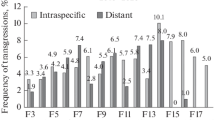Abstract—Under the conditions of Moscow oblast, we investigated 1500 samples of X. Triticosecale Wittmack of different ecological-geographical origin concentrated at the World Gene Fund of the Vavilov All-Russia Research Institute of Crop Production and new cultivars and lines of the Moscow Nemchinovka Research Institute of Agriculture (MosNIIKh) obtained using gene sources and donors of valuable traits from Dias (5 × 5) and other field experiments. Results of the analysis of diallel crosses according to the method of B.J. Hayman (1954) suggest that all studied traits of triticale are characterized by the additive dominant inheritance scheme. Thousand-grain weight and grain protein and starch content in F1 hybrids revealed overdominance. By ear grain weight, the character of inheritance varied from complete dominance to overdominance. The main contribution to the increase in productivity traits was made by dominant genes, the concentration of which was used to determine the viability of individual cross combinations. In terms of the 1000-grain weight trait, the Prag 468 line is promising, while the ADK 1369t line is promising in terms of the ear grain weight. The high starch content in the grain is due to the dominant alleles, in particular in the lines Prag 468 and 6418-145. We obtained fundamentally new varieties and lines with high rates of productivity and quality of grain, much higher than the standard cultivar Viktor. Grain yields in the control nursery of new lines (5802-10-5-6, 5802-10-5-59, and 154-11-55) ranged from 8.34 to 9.91 t/ha even under extremely adverse weather conditions in 2017. The yield of the standard cultivar Viktor was 5.04 t/ha, that is, almost two times lower than that of the line 154-11-5-5. In competitive varietal trials (2014–2017), the best cultivar was Gera. It was shown that the advantage of new genotypes over standards is that they form a well-grained ear with large full-weight grain (up to 80 grains), have increased productivity, good plant preservation for harvesting, and high resistance to environmental limiting factors.
Similar content being viewed by others
REFERENCES
Grabovets, A.I. and Krokhmal’, A.V., Specific features of triticale breeding on the Don in a changing climate, in Tritikale (Triticale), Rostov-on-Don: DZNIISKh, 2014, pp. 37–43.
Sandukhadze, B.I., Medvedev, A.M., Osipov, V.V., and Vasyutin, A.S., Tekhnologiya proizvodstva zerna ozimykh zernovykh kul’tur (The Technology for Production of Winter Grain Crops), Moscow, 2015.
Medvedev, A.M., Medvedeva, L.M., Poma, N.G., Osipov, V.V., and Osipova, A.V., Ozimaya i yarovaya tritikale v Rossiiskoi Federatsii. Kollektivnaya monografiya (Winter and Spring Triticale in the Russian Federation. Collective Monograph), Moscow: Nemchinovka, 2017.
Dospekhov, B.A., Metodika polevogo opyta (Methodology of Field Experiments), Moscow: Kolos, 1979.
Osipov, V.V. and Medvedev, A.M., On lodging resistance of winter triticale due to stem height, pathogen resistance, other stress factors, and productivity, Zernobobovye Krupyanye Kul’t., 2016, no. 2, pp. 40–46.
Grabovets, A.I., Krokhmal’, A.V., Dremucheva, G.F., and Karchevskaya, O.E., Selection of triticale for baking purposes, in Tritikale (Triticale), Rostov-on-Don, 2016, pp. 4–19.
Metodika gosudarstvennogo sortoispytaniya s.-kh. kul’tur. Vyp. 2. Zernovye, krupyanye, kormovye kul’tury (Methods of State Variety Testing of Crops. Issue 2. Grain, Cereal and Feed Crops), Moscow, 1989, p. 228.
Merezhko, A.F. and Udachin, R.A., Metodicheskie ukazaniya (Methodical Instructions), St. Petersburg, 1999.
Hayman, B.J., The analisis of variance of dialel tables, Biometries, 1954, vol. 10, pp. P. 235–244.
Mather, K. and Jinks, J.L., Biometrical Genetics. The Study of Continuous Variation, London: Chapman and Hall, 1982.
COMPLIANCE WITH ETHICAL STANDARDS
The authors declare that they have no conflict of interest. This article does not contain any studies involving animals or human participants performed by any of the authors.
Author information
Authors and Affiliations
Corresponding author
Additional information
Translated by K. Lazarev
About this article
Cite this article
Voronov, S.I., Medvedev, A.M., Osipov, V.V. et al. The Selective-Genetic Value of Winter Triticale Cultivar Samples from the Collection for Cultural Breeding in the Central Nonblack Earth Region. Russ. Agricult. Sci. 45, 105–111 (2019). https://doi.org/10.3103/S106836741902023X
Received:
Revised:
Accepted:
Published:
Issue Date:
DOI: https://doi.org/10.3103/S106836741902023X




